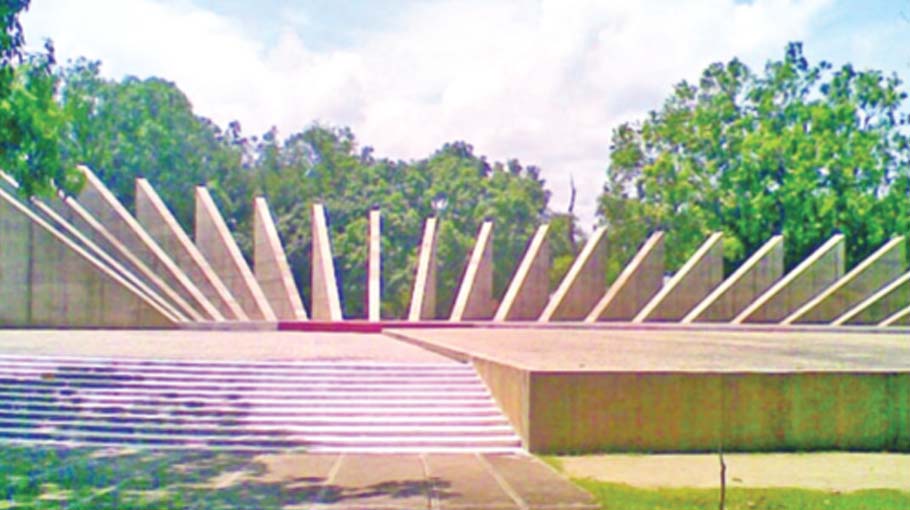Historic Mujibnagar Day today

Hasnat Zaman Sayqut
Today is April 17, Historic Mujibnagar Day, the liberation struggle for the 56 thousand square miles of Bangladesh started from this town at that time.
After Bangabandhu's speech on March 7, 1971, millions of people of Bengal joined the war for freedom. Bangabandhu Sheikh Mujbar Rahman was arrested.
On April 10, a new government was formed in Agartala, with the elected members of the 1970 elections. Bangabandhu Sheikh Mujibur Rahman was made the President of that government. This was the first government of independent Bangladesh.
On 17th April, oath taking of Mujibnagar government took place in Amrokanan. The crown of glory was placed on the head of Baidyanath-tala, a small village on the border surrounded by shady greenery. The Declaration of Independence was made. Later, after Bangabandhu, Baidyanath-tala was named Mujibnagar, and this government came to be known as Mujibnagar government. This government conducted the war of liberation. Under the leadership of this government, Bangladesh was liberated after 9 months of bloodshed.
On the morning of March 26, 12 Anshar members took over the responsibility of Mujibnagar camp from the then EPR. On April 27, the then SDO Tawfiq EIahi Chowdhury handed over the weapons to them. At that time logistics from India, weapons and various war materials were received and sent to different parts of the country through the SDO.
On the afternoon of April 16, Tawfiq Elahi Chowdhury informed them that some guests would come tomorrow morning. At night, Indian troops were not stationed across the entire Amrokanan. In the morning, four national leaders entered Mujibnagar Amrokanan along Hridoypur Road in India. Many local and foreign journalists were with them. After a while the main formality began.
The Declaration of Independence was made. As Bangabandhu was imprisoned in Pakistan, 12 Ansar members led by the then SP Mahabub Uddin Ahmed, gave guard of honour to Vice President Syed Nazrul Islam. Tajuddin Ahmed, Capt M Mansur Ali and SM Kamruzzaman were sworn in as Prime Minister, Finance Minister and Home and Rehabilitation Minister respectively.
Read More: Move to modernise Mujibnagar
At the end of the oath, they quickly left the place and returned to India. This government played an important role in creating international public opinion for Bangladesh and during the war of liberation. The ultimate victory was achieved on December 16, 1971 in exchange for the blood of 3 million martyrs. As a result of the formation of this government, the world extended its hand of support and cooperation to the Bengalis who were fighting for independence.
Political scientist and Liberation War researcher Abdullah Al Ami said that if the Mujibnagar government had not been formed, it would not have been possible to create public opinion. This movement could have become a separatist movement. At the end of the oath, many people asked what the name of this place would be. Then Prime Minister Tajuddin Ahmed said the place would be named after our leader Bangabandhu. From then on, the then Baidyanath-tala became today's Mujibnagar. Every work was organised here under the leadership of Bangabandhu. Although at that time he was a prisoner in the hands of Pakistanis.
After the war, the then Baidyanath-tala became today's Mujibnagar. Various installations based on the liberation war have been built around Mujibnagar. If you go a little further from the main gate, you will see the memorial. There are 23 pillars showing the brutality of the Pakistani army.
Layers of stones tell us that our freedom has been achieved in exchange for the honour and blood of 3 million people. The sloping part refers to the freedom gained through the exchange of seven seas of blood. Numerous circles tell the scene of the killing of intellectuals. Numerous holes in the pillars indicate bullet marks of Pakistani forces. The lower part refers to the Bay of Bengal, and the 11 stairs represent 11 wartime sectors. The 23-year brutality of the Pakistani army has been highlighted through the memorial.
The largest wartime map of Bangladesh can be seen across Amrokanan. The battle of 11 sectors has been highlighted through sculpture there. You will see scenes of refugees migrating to India, images of destruction of various structures, flags being hoisted at Dhaka University, everything from wartime to sculpture has been depicted on the map.
Bangabandhu's historic speech on March 7 can be seen next to the map. Next to it is the brutality of the Pakistani army, the scene of burning houses, next to it there are 4 national leaders, the sculpture of taking oath on 17th April, there is the surrender of the Pakistani army. Next to it is a six-tiered rose garden which has highlighted the 6-point demand of Dara Bangabandhu.
Visitors from home and abroad come here to enjoy the immense beauty of Amrokanan. As well as to know the real history of the liberation war. Visitors are happy to visit various installations based on the liberation war. As soon as you visit these installations based on the liberation war, an unknown feeling works among every visitor.




